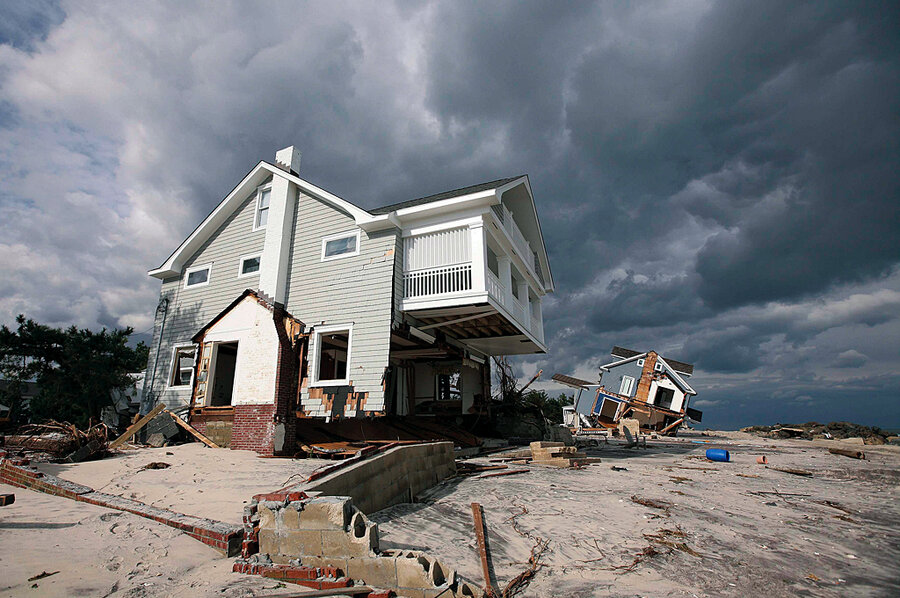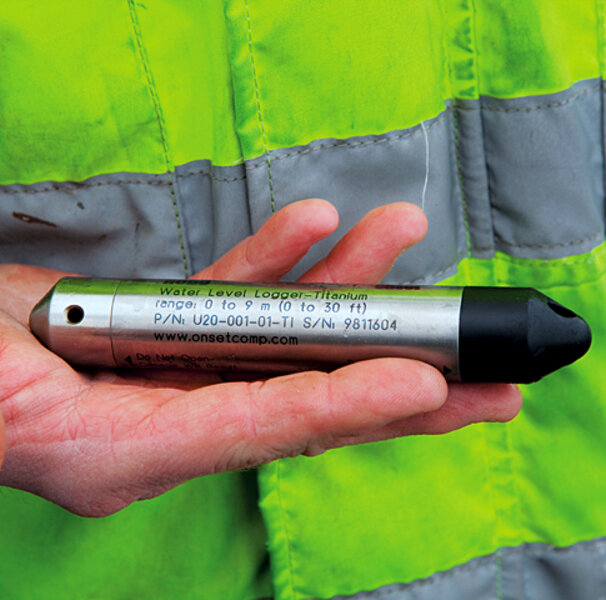Surging storms: Can the US adapt in time to avert coastal damage?
Loading...
| Sakonnet, R.I.
An afternoon breeze tousles the waters of a tiny harbor here at the mouth of Narragansett Bay – nothing like the heavy winds, rain, and storm surge superstorm Sandy brought to the East Coast as October ended.
Armed with a cordless drill, Andrew Waite, a US Geological Survey (USGS) hydrologist, drops onto his stomach and scooches far enough over the edge of a weathered wooden pier to allow him to remove a length of narrow PVC pipe from a piling. It's not a task for the squeamish: The pier's deck looks as though seabirds have used it to practice carpet bombing.
Mr. Waite and a co-worker are retrieving storm-surge gauges deployed in advance of Sandy – a scene being repeated up and down the East Coast. The USGS will use the readings (six feet at this particular site) to update flood maps, and also to check the accuracy of surge forecasts, with an eye to improving them.
Both goals could hardly be more important, as global warming raises sea levels and severe-storm activity intensifies off the Eastern Seaboard and elsewhere. Assessing the risk that storm surges pose to future coastal homes and businesses goes hand in glove with efforts to reduce vulnerability to such events.
"You think about it, and putting factors like sea level [rise] and all that aside, you're building where you're going to get flooded," Waite says. "It's just a matter of time."
Indeed, damage from tropical systems such as Sandy are projected to multiply by the end of the century as the population grows and people put more assets in harm's way. That's true whether or not global warming, which many researchers say is feeding extreme-weather events, is factored in.
Tropical-cyclone damage now runs about $26 billion a year globally, according to a study published in January in the journal Nature Climate Change. By 2100, increases in population and wealth as economies grow could push that number to $56 billion a year, assuming little or no effort to adapt to the hazard.
Throw global warming into the mix and the number grows to $109 billion a year, the researchers calculate. Most of that added burden falls on North America, where, absent efforts to adapt to the changes, damage could range from $60 billion to $70 billion a year – roughly double the rate by 2100 that assumes today's climate.
Along the US East Coast, where Sandy and last year's hurricane Irene left chaos in their wakes, a perfect storm of rising sea levels and coastal development is brewing. Forty-two percent of the dry land up to one meter above sea level is already developed, and another 15 percent is slated for partial or complete development, according to a survey of state and local coastal development agencies in the region conducted three years ago by the US Environmental Protection Agency.
If communities and developers follow through on those plans, that would bring to nearly 60 percent the proportion of dry-land coast below one meter above sea level with more people and high-priced assets in harm's way. In the process, wetlands seaward of these developed areas would have no place to migrate as the sea level rises, leaving engineered barriers as the only protection from surge flooding.
A hot spot for rising sea level
Meanwhile, USGS researchers identify the coastline from Massachusetts to Cape Hatteras, N.C., as a "unique" hot spot for sea level rise. Rates of sea level rise there are three to four times the global average, even after taking changes in land elevation into account, according to their recent study.
For New York City, in particular, a one-meter sea level rise, coupled with hurricanes that are more intense and more frequent, could by the end of the century turn a once-in-100-year-average surge flood, such as Sandy delivered, to once in three to 20 years, states a study published in February by researchers from the Massachusetts Institute of Technology and Princeton University.
That estimate is only the latest to underscore the need to adapt to greater threat of flooding due to surges from coastal storms, as well as from other extreme events.
"We're doing a bad job of living on a planet that does its business by extreme events," says William Hooke, director of the policy program at the American Meteorological Society, based in Boston.
Pre-storm forecasting and post-storm emergency responses are getting better. "We're mastering that," he says. "But we should be spending an equal amount of time on trying to reduce the need for that emergency response in the first place."
That point is underscored by an August report by the National Academies titled "Disaster Resilience: A National Imperative."
"Business as usual isn't going to protect us from future extreme events," says Gerald Galloway Jr., a University of Maryland engineering professor who served on the panel that produced the resilience report.
That recognition is already driving efforts to develop key elements of a modern world that are hardier – or at least that can be repaired sooner – when severe coastal storms strike.
Take electricity, often one of the first infrastructure casualties and, in some places, one of the last to be restored. One step that could be taken now is to bury power lines, notes Arshad Mansoor, senior vice president of the research and development group at the Electric Power Research Institute, based in Palo Alto, Calif. The priority, he adds, are lines serving a handful of customers "out there in the boonies." The reason, he says, is that feeder lines in cities and near suburbs tend to be easier to reach and repair. But technicians can't pump electricity into them until the most distant downed lines are located and fixed.
In addition, researchers are working to design poles that are more wind-resistant and water-repellent coatings for cables. Such coatings would pay dividends during winter storms, Mr. Mansoor says, by reducing the buildup of ice on lines, which can bring them down.
Others point to the value of tougher construction standards for homes built along the coast. The National Academies report cites as an example homes built on the Bolivar Peninsula on Texas' Gulf Coast. Thirteen homes in a row on the peninsula were built to FORTIFIED for Safer Living standards from the Institute for Business and Home Safety, plus with some storm-savvy additions by the local contractor.
"They were unaffectionately known at the time as the birdhouses," quips Timothy Reinhold, the institute's senior vice president for research and chief engineer, because the houses were on pilings that raised them nine feet above the ground. After hurricane Ike hit that location in 2008 with a 12-foot surge, 10 of the 13 birdhouses were still standing with the living space intact. Water leaked into the homes, but with hardwood floors and wooden walls, the structures could be reoccupied relatively quickly, if the owners had ladders tall enough to reach the door. Three of the homes were lost, not to the surge or wind per se, but to the relentless pounding of debris from other homes on the peninsula destroyed by Ike's surge.
For New York City, possible solutions to protect the metropolis from coastal flooding tend to focus on big-ticket engineering – ranging from strategically located surge barriers to artificial wetlands and restored oyster reefs. And therein lies one challenge facing areas deemed vulnerable to coastal flooding: money.
"There's clearly going to be less money" at the federal level for efforts to improve resilience, says Dr. Galloway. "Does that mean the responsibility and the funding will more and more be on the locals?"
Local authorities often aren't in a financial position to inspect, upgrade, or extend any levees or other flood-protection barriers they may have, he says. "If you don't have money, there's going to be real tough decisions; X is going to get money to protect their city and Y is not."
"I don't think that's a necessity," he adds. "It's possible for us to recognize that protecting our infrastructure and taking care of the health and welfare of the people that live in these high-risk areas is important. We may have to figure out a way to put more money into it."
Why everything can't just stay the same
Another challenge centers on personal or cultural attachments to a home, town, or geographic setting that has been heavily affected by coastal flooding or other natural hazards and likely will be again, notes Shirley Laska, a professor emeritus of sociology at the University of New Orleans and a specialist on community responses to natural hazards. Rebuilding the old neighborhood as it was before is a strong pull for residents and politicians trying to restore a sense of normalcy to a stricken area. Global warming, however, could change that predisposition.
"People will start getting it into their thinking that they have to do something if they are impacted more than once," she says. "They start accepting that they have to change the way they live, that they can't go back to the way it was."
Ultimately, she says, the goal is to move vulnerable communities "more rapidly into thinking about how to achieve the goals they have for using this place, but that it be in a safer fashion. They have to come to grips with risk reduction as they are planning their future, and it can't be tomorrow. That's what climate change is telling us."









